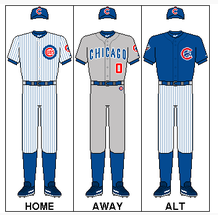
| {{{name}}} | ||
| [[2013 {{{name}}} season]] | ||
| Established | [[{{{established}}} in baseball|{{{established}}}]] | |
| {{{misc}}} | ||
|
|
||
| Major league affiliations | ||
|
National League (1876–present) Central Division (1994–present) |
||
| Current uniform | ||
|
||
| Retired numbers | 10, 14, 23, 26, 31, 31,42 | |
| Colors | ||
| {{{colors}}} | ||
| Name | ||
| {{{name}}} (1903–present) | ||
|
Chicago Orphans (1898–1902) Chicago Colts (1890–1897) Chicago White Stockings (1870–1871, 1874–1889) (a.k.a. Remnants 1898–1901) |
||
| Other nicknames | ||
| The Cubbies, the North Siders, the Boys in Blue, the Loveable Losers | ||
| Ballpark | ||
|
Wrigley Field (1916–present) a.k.a. Cubs Park (1920–1926) a.k.a. Weeghman Park (1916–1920) West Side Park (II) (1893–1915) South Side Park (1891–1893) West Side Park (I) (1885–1891) Lakefront Park (II) (1883–1884) Lakefront Park (I) (1878–1882) 23rd Street Grounds (1875–1877) Ogden Park (1874) 23rd Street Grounds (1874) Union Base-Ball Grounds (1871) Dexter Park (1870) |
||
| Major league titles | ||
| World Series titles{{{WS}}} | {{{WORLD CHAMPIONS}}} | |
| NL Pennants {{{P}}} |
1945 • 1938 • 1935 • 1932 1929 • 1918 • 1910 • 1908 1907 • 1906 • 1886 • 1885 1882 • 1881 • 1880 • 1876 |
|
| 1870 (amateur) | ||
| Central Division titles (3) | 2008 • 2007 • 2003 | |
| East Division titles(2) | 1989 • 1984 | |
| Wild card berths (1) | 1998 | |
| Front office | ||
| Owner(s) | {{{owner}}} | |
| Manager | {{{manager}}} | |
| General Manager | {{{gm}}} | |
| Level | Team | League | Location |
| AAA | Iowa Cubs | Pacific Coast League | Des Moines, IA |
| AA | Tennessee Smokies | Southern League | Sevierville, TN |
| Advanced A | Daytona Cubs | Florida State League | Daytona Beach, FL |
| A | Kane County Cougars | Midwest League | Geneva, IL |
| Short Season A | Boise Hawks | Northwest League | Boise, ID |
| Rookie | AZL Cubs | Arizona League | Mesa, AZ |
| DSL Cubs | Dominican Summer League | Boca Chica, Dominican Republic | |
| VSL Cubs | Venezuelan Summer League | Venezuela |
The Cubs have not won the World Series in 104 years, the longest championship drought of any major North American professional sports team,[1][2] and are often referred to as the "Lovable Losers" because of this distinction. They are also known as "The North Siders" because Wrigley Field, their home park since 1916, is located in Chicago's north side Lake View community at 1060 West Addison Street (as opposed to their crosstown rivals, the Chicago White Sox, who play on the city's South Side).
The club played its first games in 1870 as the Chicago White Stockings. This makes the Cubs, along with the Braves who were founded in 1871, the two oldest active teams in major North American sports. There is an argument as to who is actually older because although the Cubs are a full season "older" they lost two seasons to the Great Chicago Fire; thus the Braves have played more seasons. The Cubs are still the longest continuously existing franchise (notwithstanding the two lost seasons), having existed in the same city for their entire history. The Cubs are characterized by their 100+ year World-Series-winning drought (last won in 1908).
Early Club History
Main article: Chicago Cubs franchise history
Further information: List of Chicago Cubs seasons
1870-1875:The Beginning
Although 1876 is generally recognized as the birth-year of the Cubs franchise, the Chicago club was initially founded in 1870 as the Chicago White Stockings and played a single season in a pro-am league called the National Association of Base Ball Players. The White Stockings won that league's championship and followed that effort playing the next five seasons (with the exception of 1872 and 1873, when the club temporarily ceased operations following the Great Chicago Fire) in the National Association of Professional Base Ball Players along with the Boston Red Stockings (now the Atlanta Braves). Both of these early leagues were hampered by a variety of ethical issues, such as the "throwing" of games and the league's inability (or unwillingness) to enforce rules and player contracts. Because of these challenges, William Hulbert, the president of the Chicago club, spearheaded the development of the National League, whose inaugural season was 1876.
1876–1902: A National League dynasty
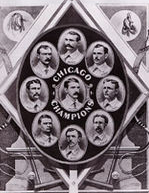
The 1876 White Stockings won the N.L. Championship
Hulbert signed multiple star players, such as pitcher Albert Spalding and infielders Ross Barnes, Deacon White, and Adrian "Cap" Anson, to join the team prior to the N.L.'s first season. The White Stockings played their home games at West Side Grounds, and quickly established themselves as one of the new league's top teams. Spalding won 47 games and Barnes led the league in hitting at .429 as Chicago won the first ever National League pennant, which at the time was the game's top prize.
After back-to-back pennants in 1880 and 1881, Hulbert died, and Spalding, who had retired to start Spalding sporting goods, assumed ownership of the club. The White Stockings, with Anson acting as player/manager, captured their third consecutive pennant in 1882, and Anson established himself as the game's first true superstar. In 1885 and '86, after winning N.L. pennants, the White Stockings met the short-lived American Association champion in that era's version of a World Series. Both seasons resulted in matchups with the St. Louis Brown Stockings, with the clubs tying in 1885 and with St. Louis winning in 1886. This was the genesis of what would eventually become one of the greatest rivalries in sports. In all, the Anson-led Chicago Base Ball Club won six National League pennants between 1876 and 1886. As a result, Chicago's club nickname transitioned, and by 1890 they had become known as the Chicago Colts,[3] or sometimes "Anson's Colts," referring to Cap's influence within the club. Anson was the first player in history credited with collecting 3,000 career hits. After a disappointing record of 59-73 and a 9th place finish in 1897, Anson was released by the Cubs as both a player and manager.[4] Due to Anson's absence from the club after 22 years, local newspaper reporters started to refer to the Cubs as the "Orphans".[4]
After the 1900 season, the American Base-Ball League formed as a rival professional league, and incidentally the club's old White Stockings nickname would be adopted by a new American League neighbor to the south.[5]
1902–1920: A Cub dynasty
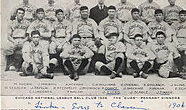
The 1906 Cubs won a record 116 of 154 games. They then won back to back World Series titles in 1907–08
In 1902, Spalding, who by this time had revamped the roster to boast what would soon be one of the best teams of the early century, sold the club to Jim Hart, and the franchise became known as the Chicago Cubs.[6] During this period, which has become known as baseball's dead-ball era, Cub infielders Joe Tinker, Johnny Evers, and Frank Chance were made famous as a double-play combination by Franklin P. Adams' poem Baseball's Sad Lexicon. The poem first appeared in the July 18, 1910 edition of the New York Evening Mail. Mordecai "Three-Finger" Brown, Jack Taylor, Ed Reulbach, Jack Pfiester, and Orval Overall were several key pitchers for the Cubs during this time period. With Chance acting as player-manager from 1905 to 1912, the Cubs won four pennants and two World Series titles over a five-year span. Although they fell to the "Hitless Wonders" White Sox in the 1906 World Series, the Cubs recorded a record 116 victories and the best winning percentage (.763) in Major League history. With mostly the same roster, Chicago won back-to-back World Series championships in 1907 and 1908, becoming the first Major League club to play three times in the Fall Classic and the first to win it twice. However, the Cubs have not won a World Series since; this remains the longest championship drought in North American professional sports.
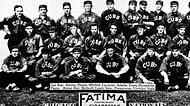
1913 Cubs
The next season, veteran catcher Johnny Kling left the team to become a professional pocket billiards player. Some historians think Kling's absence was significant enough to prevent the Cubs from also winning a third straight title in 1909, as they finished 6 games out of first place.[7] When Kling returned the next year, the Cubs won thepennant again, but lost to the Philadelphia Athletics in the 1910 World Series.
In 1914, advertising executive Albert Lasker obtained a large block of the club's shares and before the 1916 season assumed majority ownership of the franchise. Lasker brought in a wealthy partner, Charles Weeghman, the proprietor of a popular chain of lunch counters who had previously owned the Chicago Whales of the short-lived Federal League. As principal owners, the pair moved the club from the West Side Grounds to the much newer Weeghman Park, which had been constructed for the Whales only two years earlier. The Cubs responded by winning a pennant in the war-shortened season of 1918, where they played a part in another team's curse: the Boston Red Sox defeated Grover Cleveland Alexander's Cubs four games to two in the 1918 World Series, Boston's last Series championship until 2004.
Beginning in 1916, Bill Wrigley of chewing-gum fame acquired an increasing quantity of stock in the Cubs. By 1921 he was the majority owner, maintaining that status into the 1930s.
Meanwhile, the year 1919 saw the start of the tenure of Bill Veeck, Sr. as team president. Veeck would hold that post throughout the 1920s and into the 30s. The management team of Wrigley and Veeck came to be known as the "double-Bills."
The Wrigley years (1921–1981)
1929–1938: Every three years

Club logo 1927 - 1936[8]
Near the end of the first decade of the double-Bills' guidance, the Cubs won the NL pennant in 1929 and then achieved the unusual feat of winning a pennant every three years, following up the 1929 flag with league titles in 1932, 1935, and 1938. Unfortunately, their success did not extend to the Fall Classic, as they fell to their AL rivals each time. The '32 series against the Yankees featured Babe Ruth's "called shot" at Wrigley Field in Game 3. There were some historic moments for the Cubs as well; In 1930, Hack Wilson, one of the top home run hitters in the game, had one of the most impressive seasons in MLB history, hitting 56 home runs and establishing the current runs-batted-in record of 191. The club claimed the '35 pennant in thrilling fashion, winning a record 21 games in a row in September. The '38 club saw Dizzy Dean lead the team's pitching staff and provided a historic moment when they won a crucial late-season game at Wrigley Field over the Pittsburgh Pirates with a walk-off home run by Gabby Hartnett, which became known in baseball lore as "The Homer in the Gloamin'".[9]
After the "double-Bills" (Wrigley and Veeck) died in 1932 and 1933 respectively, P.K. Wrigley, son of Bill Wrigley, took over as majority owner. He was unable to extend his father's baseball success beyond 1938, and the Cubs slipped into years of mediocrity, although the Wrigley family would retain control of the team until 1981.
1945: The Curse
Main article: Curse of the Billy Goat
The Cubs enjoyed one more pennant at the close of World War II, finishing 98–56. Due to the wartime travel restrictions, the first three games of the 1945 World Series were played in Detroit, where the Cubs won two games, including a one-hitter by Claude Passeau, and the final four were played at Wrigley. In Game 4 of the Series, the Curse of the Billy Goat was allegedly laid upon the Cubs when P.K. Wrigley ejected Billy Sianis, who had come to Game 4 with two box seat tickets, one for him and one for his goat. They paraded around for a few innings, but Wrigley demanded the goat leave the park due to its unpleasant odor. Upon his ejection, Mr. Sianis uttered, "The Cubs, they ain'tgonna win no more." The Cubs lost Game 4, lost the Series, and have not been back since. It has also been said by many that Sianis put a "curse" on the Cubs, apparently preventing the team from playing in the World Series. After losing the 1945 World Series to the Detroit Tigers, the Cubs finished with winning seasons the next two years, but those teams did not enter post-season play.
In the following two decades after Sianis' ill will, the Cubs played mostly forgettable baseball, finishing among the worst teams in the National League on an almost annual basis. Longtime infielder/manager Phil Cavarretta, who had been a key player during the '45 season, was fired during spring training in 1954 after admitting the team was unlikely to finish above fifth place. Although shortstop Ernie Banks would become one of the star players in the league during the next decade, finding help for him proved a difficult task, as quality players such as Hank Sauer were few and far between. This, combined with poor ownership decisions (such as the College of Coaches), hampered on-field performance.
1969: The Fall of '69
Main article: 1969 Chicago Cubs season
The late-1960s brought hope of a renaissance, with third baseman Ron Santo, pitcher Ferguson Jenkins, and outfielder Billy Williams joining Banks. After losing a dismal 103 games in 1966, the Cubs brought home consecutive winning records in '67 and '68, marking the first time a Cub team had accomplished that feat in over two decades.
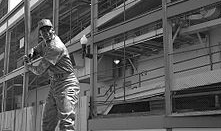
Ernie Banks statue at Wrigley
In 1969 the Cubs, managed by Leo Durocher, built a substantial lead in the newly created National League Eastern Division by mid-August. Ken Holtzman pitched a no-hitter on August 19, and the division lead grew to 8 1⁄2 games over the St. Louis Cardinals and by 9 1⁄2 games over the New York Mets. After the game of September 2, the Cubs record was 84-52 with the Mets in second place at 77-55. But then a losing streak began just as a Mets winning streak was beginning. The Cubs lost the final game of a series at Cincinnati, then came home to play the resurgent Pittsburgh Pirates (who would finish in third place). After losing the first two games by scores of 9-2 and 13-4, the Cubs led going into the ninth inning. A win would be a positive springboard since the Cubs were to play a crucial series with the Mets the very next day. But Willie Stargell drilled a 2-out, 2-strike pitch from the Cubs' ace reliever, Phil Regan, onto Sheffield Avenue to tie the score in the top of the ninth. The Cubs would lose 7-5 in extra innings.[6]
Burdened by a four-game losing streak, the Cubs traveled to Shea Stadium for a short two-game set. The Mets won both games, and the Cubs left New York with a record of 84-58 just 1⁄2 game in front. Disaster followed in Philadelphia, as a 99 loss Phillies team nonetheless defeated the Cubs twice, to extend Chicago's losing streak to eight games. In a key play in the second game, on September 11, Cubs starter Dick Selma threw a surprise pickoff attempt to third baseman Ron Santo, who was nowhere near the bag or the ball. Selma's throwing error opened the gates to a Phillies rally. After that second Philly loss, the Cubs were 84-60 and the Mets had pulled ahead at 85-57. The Mets would not look back. The Cubs' eight-game losing streak finally ended the next day in St. Louis, but the Mets were in the midst of a ten-game winning streak, and the Cubs, wilting from team fatigue, generally deteriorated in all phases of the game.[1] The Mets (who had lost a record 120 games 7 years earlier), would go on to win the World Series. The Cubs, despite a respectable 92-70 record, would be remembered for having lost a remarkable 17 1⁄2 games in the standings to the Mets in the last quarter of the season.
1977–1979: The June Swoon
Main article: 1977 Chicago Cubs season
Following the '69 season, the club posted winning records for the next few seasons, but no playoff action. After the core players of those teams started to move on, the 70s got worse for the team, and they became known as "The Loveable Losers." In 1977, the team found some life, but ultimately experienced one of its biggest collapses. The Cubs hit a high-water mark on June 28 at 47–22, boasting an 8 1⁄2 game NL East lead, as they were led by Bobby Murcer (27 Hr/89 RBI), and Rick Reuschel (20–10). However, the Philadelphia Phillies cut the lead to two by the All-star break, as the Cubs sat 19 games over .500, but they swooned late in the season, going 20–40 after July 31. The Cubs finished in 4th place at 81–81, while Philadelphia surged, finishing with 101 wins. The following two seasons also saw the Cubs get off to a fast start, as the team rallied to over 10 games above .500 well into both seasons, only to again wear down and play poorly later on, and ultimately settling back to mediocrity. This trait became known as the "June Swoon." Again, the Cubs' unusually high number of day games is often pointed to as one reason for the team's inconsistent late season play.
P.K. Wrigley died in 1977. The Wrigley family sold the team to the Chicago Tribune in 1981, ending a 65-year family relationship with the Cubs.
Tribune Company years (1981–2008)


